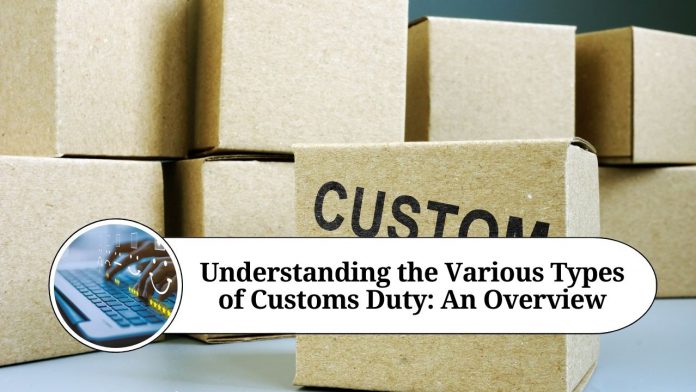Introduction
Customs duty is a tax that governments impose on imported goods. This tax is typically based on the value of the goods or on the quantity of goods being imported. Customs duty can be an important source of revenue for governments, and it can also be used to protect domestic industries and encourage local production.
Customs duty can be broadly classified into two types: ad valorem duty and specific duty.
- Ad valorem duty: Ad valorem duty is a type of customs duty that is calculated as a percentage of the value of imported goods. This type of duty is based on the price paid or payable for the goods being imported. The percentage rate of the duty can vary depending on the type of goods being imported and the country of origin. Ad valorem duty is the most common type of customs duty and is used in most countries around the world.
- Specific duty: Specific duty is a type of customs duty that is calculated based on the quantity of the goods being imported. The duty is expressed in terms of a fixed amount per unit of measurement. For example, a specific duty on a particular type of cloth may be expressed as a fixed amount per meter or per square meter of cloth. This type of duty is used for goods that are difficult to value or where the value of the goods is not a good indicator of the level of protection required.
In addition to ad valorem duty and specific duty, there are a number of other types of customs duty that may be applied in specific circumstances. These include:
- Anti-dumping duty: Anti-dumping duty is a type of customs duty that is imposed to counteract the effects of goods being sold at prices lower than their normal value in the exporting country. This can occur when foreign manufacturers sell their goods in another country at a lower price than they do in their home country in order to gain an unfair advantage over local manufacturers. Anti-dumping duty is intended to level the playing field and protect local industries.
- Countervailing duty: Countervailing duty is a type of customs duty that is imposed to counteract the effects of foreign government subsidies on imported goods. This can occur when foreign governments provide financial or other types of support to their exporters, giving them an unfair advantage over local manufacturers. Countervailing duty is intended to neutralize the effects of such subsidies and protect local industries.
- Excise duty: Excise duty is a type of customs duty that is imposed on specific types of goods that are considered to be harmful or socially undesirable. This can include goods such as alcohol, tobacco, and certain types of fuel. The purpose of excise duty is not only to generate revenue for the government but also to discourage the consumption of these goods.
In addition to the types of customs duty mentioned in my previous response, there are several other types of customs duty that may be imposed in certain situations. Some of these additional types of customs duty include:
Safeguard duty: Safeguard duty is a type of customs duty that is imposed to protect domestic industries from a sudden surge in imports that could cause serious harm. This type of duty is only applied in exceptional circumstances, such as when a surge in imports threatens to cause significant injury to domestic industries.
Transit duty: Transit duty is a type of customs duty that is levied on goods passing through a country but are not intended for consumption within that country. This type of duty is typically used to generate revenue for the country in which the goods are passing through, rather than the country of origin or destination.
Retaliatory duty: Retaliatory duty is a type of customs duty that is imposed by one country in response to the imposition of duties by another country. This type of duty is used as a retaliatory measure in response to what is perceived as unfair trade practices by another country.
Preferential duty: Preferential duty is a type of customs duty that is lower than the standard duty rate and is applied to goods that are imported from certain countries. This type of duty is typically applied to countries that have a preferential trade agreement with the importing country and is intended to encourage trade between the two countries.
Environmental duty: Environmental duty is a type of customs duty that is imposed on goods that have a negative impact on the environment. This can include goods such as certain chemicals or products that contribute to pollution. The purpose of this type of duty is to encourage the use of more environmentally friendly products and to discourage the consumption of products that are harmful to the environment.
In summary
Customs duty is an important source of revenue for governments, and it can also be used to protect domestic industries and encourage local production. The various types of customs duty that can be imposed include ad valorem duty, specific duty, anti-dumping duty, countervailing duty, excise duty, safeguard duty, transit duty, retaliatory duty, preferential duty, and environmental duty. Each type of duty is designed to achieve a specific objective, and the specific type of duty that is applied will depend on the circumstances and the objectives of the government in question.
Read more useful content:
- section 234e of income tax act
- section 286 of income tax act
- section 90a of income tax act
- section 40a(7) of income tax act
- section 226(3) of income tax act
- section 24 of income tax act
Frequently Asked Questions (FAQs)
Q:1 What is ad valorem duty?
A: Ad valorem duty is a type of customs duty that is calculated as a percentage of the value of imported goods. This type of duty is based on the price paid or payable for the goods being imported.
Q:2 What is specific duty?
A: Specific duty is a type of customs duty that is calculated based on the quantity of the goods being imported. The duty is expressed in terms of a fixed amount per unit of measurement.
Q:3 What is anti-dumping duty?
A: Anti-dumping duty is a type of customs duty that is imposed to counteract the effects of goods being sold at prices lower than their normal value in the exporting country. This can occur when foreign manufacturers sell their goods in another country at a lower price than they do in their home country in order to gain an unfair advantage over local manufacturers.
Q:4 What is countervailing duty?
A: Countervailing duty is a type of customs duty that is imposed to counteract the effects of foreign government subsidies on imported goods. This can occur when foreign governments provide financial or other types of support to their exporters, giving them an unfair advantage over local manufacturers.
Q:5 What is excise duty?
A: Excise duty is a type of customs duty that is imposed on specific types of goods that are considered to be harmful or socially undesirable. This can include goods such as alcohol, tobacco, and certain types of fuel.
Q:6 What is safeguard duty?
A: Safeguard duty is a type of customs duty that is imposed to protect domestic industries from a sudden surge in imports that could cause serious harm.
Q:7 What is transit duty?
A: Transit duty is a type of customs duty that is levied on goods passing through a country but are not intended for consumption within that country.
Q:8 What is retaliatory duty?
A: Retaliatory duty is a type of customs duty that is imposed by one country in response to the imposition of duties by another country.
Q:9 What is preferential duty?
A: Preferential duty is a type of customs duty that is lower than the standard duty rate and is applied to goods that are imported from certain countries.
Q:10 What is environmental duty?
A: Environmental duty is a type of customs duty that is imposed on goods that have a negative impact on the environment.




















